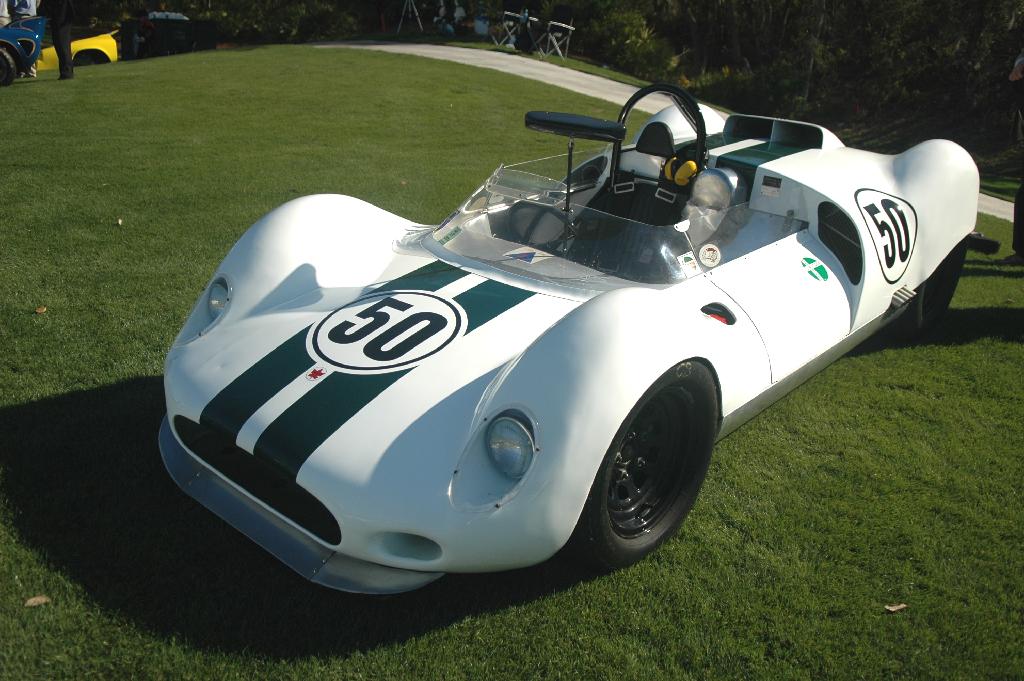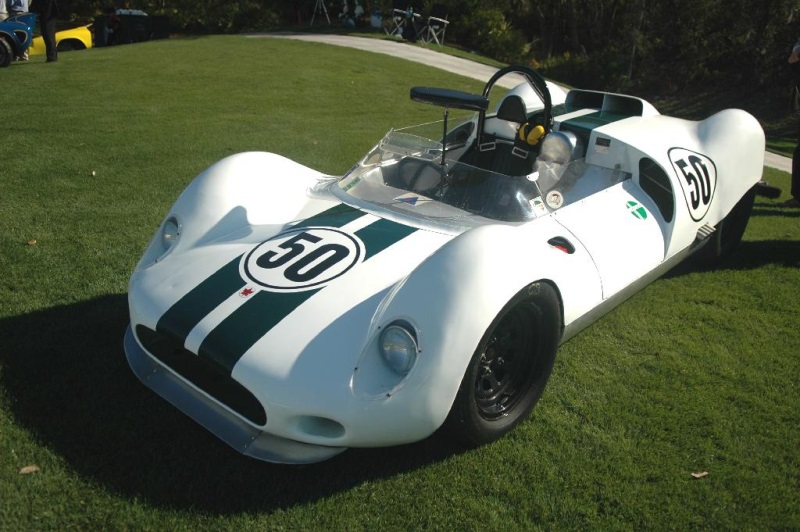1960 Sadler MK5 Navigation
History
Canadian-born Bill Sadler built many big-engine sports racers, Specials, and Formula cars during the 1950s. His first creation was the MK1, which was soon followed by the MK2, MK3, MK4, and lastly the MK5. The MK1 had a ladder frame and an aluminum body which was later replaced with a fiberglass body that was more attractive. Power was from a Triumph TR2 engine fitted with a fuel-injection system of Sadler's design. In 1955, the engine was replaced after throwing a rod with a Chevrolet V8 engine that displaced 265 cubic inches. It had two four-barrel carburetors and produced around 200 horsepower which was sent to the rear wheels via the Triumph gearbox assembly.
The V8 engine was a monster within the MK1, so Sadler set out to design and build a car better suited to this raw power. The MK2 consisted of a ladder tubular frame that featured a leaf spring suspension in the front and a low-pivot swing axle setup in the rear. A 1934 preselector gearbox and drum brakes were installed with hopes of taming the V8 engine. The MK1 fiber-glass body was removed and placed on the MK2. Later in the car's history, the engine was removed and replaced with a 283 cubic-inch unit which had its bored out to 300 ci.
He brought the car over to Europe and pitted it against the competitive European makes, occasionally outpacing the rest of the pack, such as at the Brighton Speed Trials, where his MKII proved to be the fastest.
Upon his return to Canada, Sadler removed the front drum brakes and replaced them with discs. Modifications were made to the engine and aluminum body panels replaced the old body.
He continued to race the MKII during the 1958 season, winning at the Watkins Glen Classic and managing to run near the front in many other races.
For the following season, Sadler found sponsorship through Earl Nisonger, the president of an auto parts company. With this new found funding, Sadler began building a new racer, one with a space frame chassis that could sit lower to the ground. Disc brakes with aluminum calipers were on all four corners of the car. The suspension was comprised of a low-pivot swing axle in the rear and front A-arms with coil-over Koni shocks. In the engine bay was a Chevrolet 327 cubic-inch engine breathing through a Hillborn fuel-injection system and producing a very heft 340 horsepower. A Borg-Warner T-10 four-speed gearbox was used to handle this power.
The Sadler MK3 was a sophisticated and modern machine but it failed to acquire the expected results.
The MK3 was followed by the MK4 which was very similar in many ways. Both rested on an 86-inch wheelbase, both had an aluminum body, Girling disc brakes, and weighed just under 1700 pounds. The MK3 had a swing axle rear setup while the MK4 was given a live axle. The MK4 was intended to become a series production machine but only one was ever created.
For the first time in the MK Sadler Series, the MK5 broke the string of 'one example created.' There were two examples of the MK5 created, featuring many changes over its predecessors. The most dramatic was its mid-engine setup resting in a space-frame chassis and clothed in an attractive aluminum body. A Halibrand quick-change rear end and two-speed transaxle were used, along with Girling disc brakes on all four corners.
The two cars were used during the 1961 season. When they were not plagued by reliability and teething problems, they proved to be rather quick. Sadler abruptly left the team after a disagreement with the sponsor, Comstock Construction.
Only one of the two MK5 examples exists in modern times, as one was destroyed in a fire.
By Daniel Vaughan | Feb 2008
The V8 engine was a monster within the MK1, so Sadler set out to design and build a car better suited to this raw power. The MK2 consisted of a ladder tubular frame that featured a leaf spring suspension in the front and a low-pivot swing axle setup in the rear. A 1934 preselector gearbox and drum brakes were installed with hopes of taming the V8 engine. The MK1 fiber-glass body was removed and placed on the MK2. Later in the car's history, the engine was removed and replaced with a 283 cubic-inch unit which had its bored out to 300 ci.
He brought the car over to Europe and pitted it against the competitive European makes, occasionally outpacing the rest of the pack, such as at the Brighton Speed Trials, where his MKII proved to be the fastest.
Upon his return to Canada, Sadler removed the front drum brakes and replaced them with discs. Modifications were made to the engine and aluminum body panels replaced the old body.
He continued to race the MKII during the 1958 season, winning at the Watkins Glen Classic and managing to run near the front in many other races.
For the following season, Sadler found sponsorship through Earl Nisonger, the president of an auto parts company. With this new found funding, Sadler began building a new racer, one with a space frame chassis that could sit lower to the ground. Disc brakes with aluminum calipers were on all four corners of the car. The suspension was comprised of a low-pivot swing axle in the rear and front A-arms with coil-over Koni shocks. In the engine bay was a Chevrolet 327 cubic-inch engine breathing through a Hillborn fuel-injection system and producing a very heft 340 horsepower. A Borg-Warner T-10 four-speed gearbox was used to handle this power.
The Sadler MK3 was a sophisticated and modern machine but it failed to acquire the expected results.
The MK3 was followed by the MK4 which was very similar in many ways. Both rested on an 86-inch wheelbase, both had an aluminum body, Girling disc brakes, and weighed just under 1700 pounds. The MK3 had a swing axle rear setup while the MK4 was given a live axle. The MK4 was intended to become a series production machine but only one was ever created.
For the first time in the MK Sadler Series, the MK5 broke the string of 'one example created.' There were two examples of the MK5 created, featuring many changes over its predecessors. The most dramatic was its mid-engine setup resting in a space-frame chassis and clothed in an attractive aluminum body. A Halibrand quick-change rear end and two-speed transaxle were used, along with Girling disc brakes on all four corners.
The two cars were used during the 1961 season. When they were not plagued by reliability and teething problems, they proved to be rather quick. Sadler abruptly left the team after a disagreement with the sponsor, Comstock Construction.
Only one of the two MK5 examples exists in modern times, as one was destroyed in a fire.
By Daniel Vaughan | Feb 2008
- 1960 Sadler MK5 Menu
- Article
- Image gallery
- Specifications
- Production figures
1960 Sadler MK5 Vehicle Profiles
Recent Vehicle Additions
Related Automotive News

Wiesmann Returns With A Brand New Car, To Be Revealed 2020
First details of Project Gecko – named after the marques logo
Modern take on the cult MF5 model
A pure drivers car with front mid-engine and rear-wheel-drive layout
Powered by BMW Ms TwinPower Turbo 8-cylinder petrol engine
Production starts...

The Best Of Aston Martin Set For Monterey Car Week
Three North American Debuts for the British Sportscar Maker exceptional new Valhalla mid-engined hypercar, stunning DB4 GT Zagato Continuation heritage model and Bijan edition bespoke DBS Superleggera
Aston Martin partners with RM Sothebys for in...

Record-Breaker: Volkswagen To Present Legendary Automobiles During The 2019 Classic Days At Schloss Dyck
Volkswagen Classic presenting five famous vehicles at Schloss Dyck from 2nd to 4th August
Six decades of Volkswagen history with the Mille Miglia Beetle, the VW-Porsche 9144 and the Volkswagen W12 Nardo
Record-breaking electric race car ID.R ma...

THE McLAREN F1
FOR THE DRIVER VITALLY – AS IN ONE OF McLARENS WORLD CHAMPION RACING CARS – DRIVER AND VEHICLE BECOME ENTIRELY AS ONE
The primary design consideration for the McLaren F1 has been to make it without reserve a drivers car, an extremely high-performance...

1958 Monaco Grand Prix: An Unlikely Frenchman Steals the Show…Again
In 1955, perhaps the most unlikely of drivers would survive the attrition and the beckoning Monaco harbor to claim his only victory in Formula One. Some three years later, and more unlikely than ever to even win a second race at any circuit, the same...










